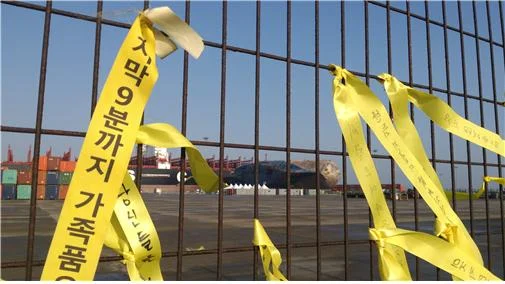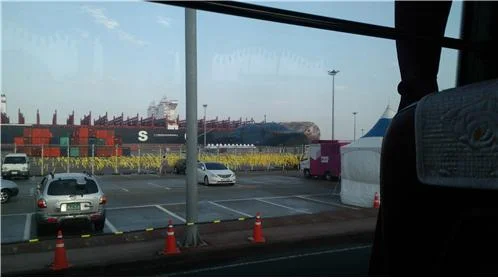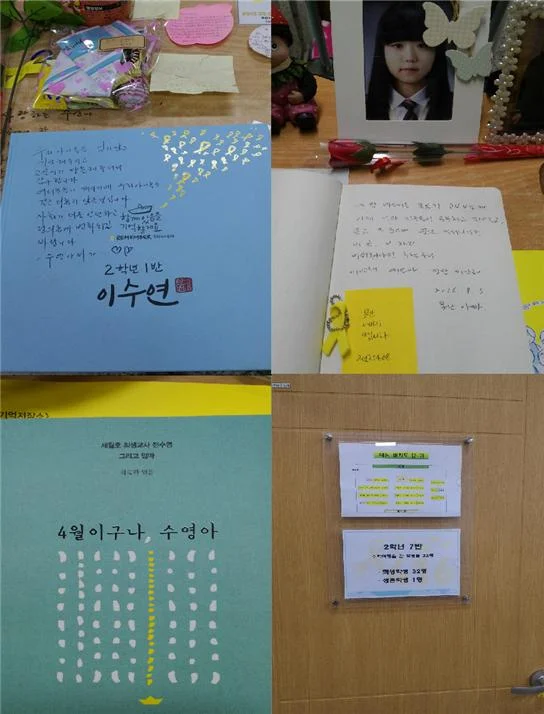A day I’ll never forget
Written by Soyun Woo
There is an unforgettable day. You can’t and shouldn’t forget the day, its memory wrings your heart, forms a lump in your throat and tears your eyes and turns them red: April 16, 2014 is such a day. It’s been 3 years since the tragedy, but for some, time stopped that day.
The day also left a deep scar in my heart. I watched live on television as the ferry sank into the sea with 304 passengers. Reality was more brutal than fiction. I was struck by the fear of chaos sweeping the world and the collapsing of society’s order. I was devastated and frustrated that I was living in a world where there is nothing to protect me, to trust in, and to rely on. So, to my shame, I hesitated visiting Ansan for a long time. I didn’t think I could face the portraits spread out like a high school yearbook in its memorial altar. However, as one writer has said, I had to open my eyes and face the harsh reality because “there are children who cannot close their eyes and rest in peace if we shut our eyes and face away.”
On April 15 of 2017, the day before the third year of the Sewol tragedy, I embarked upon “The bus of remembrance and resolution.” After three years, the Sewol had finally been recovered. It felt unreal seeing it on TV. So, I got on a bus to give it proper reception and to remember.
After five hours, the bus arrived in Mokpo. As it was nearing the road to Mokpo New Port, a ship lying on its side came into view. It was the Sewol. On a sunny day in mid-April, under the clear and blue sky, this worn-out ferry was showing its bottom still covered with dirt.
Getting off the bus, I had to look at the Sewol from far away through a steel fence because only investigation committee members, investigators, and police officers were allowed access to.
Inside the ferry, there are still the nine victims unaccounted for. Where do they reside in this large ship? We have to go there and find them… The families of those nine victims are staying at a temporary shelter at Mokpo New Port and waiting for their family members to return as each day lasts a thousand years.
After seeing the Sewol, others who took the bus gathered to hear Hoon Jang, the father of Junyoung Jang, a second grader in Class 8. According to him, families of victims do not see the Sewol tragedy as a failed rescue mission. Calling it a failure would have required the coast guard to put their all and utmost efforts to save the passengers on board. However, the coast guard did not even enter the cabin in which children cried for help. They could have simply shouted, “Come out!” but nobody did.
What has changed after the Sewol disaster? The ferry has been raised only after President Park was removed from office. No truth has been revealed – why did it sink into the sea, why were the 304 passengers not rescued. Our yearning for a safer society has grown stronger, but I am not sure about what actions have been taken and what achievements were made by this society. Mr. Jang said that he thinks the ferry should be preserved as a symbol of a safer society. To achieve that, people’s support is essential.
He concluded by asking us to remember five things, still deeply inscribed in my mind: “Get angry, remember, act out, stand together, and… love yourself.” We cannot remember unless we are angry at injustice, we cannot act unless we remember, and we cannot stand together unless we act out. But why love ourselves…? He, of the most hurt and worn out, smiled and explained, “You cannot love your neighbors and people around you unless you love yourself. So, when you return to your home, say you love your family three times a day.”
Leaving behind the Sewol in Mokpo, the bus headed to Ansan. After passing a road filled with cherry blossoms at full bloom, it arrived at Ansan Office of Education. An annex to the office displays the representation of the classrooms of Danwon High School’s second graders. These classrooms are named, the “Classrooms of Remembrance.” The first and second floors of the building feature Classes 1 to 10, which are filled with letters and memorial items of the deceased students and teachers. Before getting on the bus, I resolved to face the Sewol disaster head-on while maintaining my composure. That was easily broken, and I burst into tears the moment I stepped into Class 1. A message from Suyeon’s father thanking us for remembering the students and visiting the Classrooms of Remembrance, a memo written by Kyunggeun Yoo, Ye-eun’s father calling himself a “stupid father,” apologizing to his daughter, remarks from Sooyoung Jeon’s mother, a teacher, and only survivor of Class 7. I wondered what life for this classroom’s lone survivor was like. Individuals’ pain and grief endlessly continued in various forms.
Although the Sewol has been raised, and the belongings have been slowly recovered, the real truth we want to know is still buried. The families of the Sewol victims and civil society have fought for the truth for three years, but still, we are only looking at the traces of 304 victims.
In front of the Sewol, Jongmin Kim, co-president of Together Seoul, said, “When we say we remember something, it means that we remember a moment in history. And remembering a moment in history is about what position we choose to stand in. During Japanese colonial rule, upon seeing steel ships anchored off Gunsan, some chose to become independence activists and others to become pro-Japanese collaborators. Upon seeing the Sewol, what will we choose? Which path will I take? He added, “Making a resolution is making a decision. To decide, we need to start by cutting something off. What deep rooted evils do we need to root out, what must we discard to change society and prevent another tragedy like the Sewol from repeating? If we can do this, society will move forward and change. That is why we embarked on the bus of remembrance and resolution.”
What must I remember and resolve? The thoughts keep me up at night.



